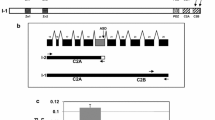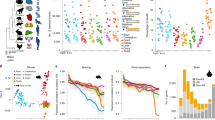Abstract
We have investigated the genomic organization, the occurrence of alternative splicing and the differential expression of the zebrafish disabled1 (dab1) gene. Dab1 is a key effector of the Reelin pathway, which regulates neuronal migration during brain development in vertebrates. The coding region of the zebrafish dab1 gene spans over 600 kb of genomic DNA and is composed of 15 exons. Alternative splicing in a region enriched for tyrosine residues generates at least three different isoforms. These isoforms are developmentally regulated and show differential tissue expression. Comparison with mouse and human data shows an overall conservation of the genomic organization with different alternative splicing events generating species-specific isoforms. Because these alternative splicing events give rise to isoforms with different numbers of phosphorylateable tyrosines, we speculate that alternative splicing of the dab1 gene in zebrafish and in other vertebrates regulates the nature of the cellular response to the Reelin signal.



Similar content being viewed by others
References
Arnaud L, Ballif BA, Cooper JA (2003a) Regulation of protein tyrosine kinase signaling by substrate degradation during brain development. Mol Cell Biol 23(24):9293–9302
Arnaud L, Ballif BA, Forster E, Cooper JA (2003b) Fyn tyrosine kinase is a critical regulator of disabled-1 during brain development. Curr Biol 13(1):9–17
Ballif BA, Arnaud L, Cooper JA (2003) Tyrosine phosphorylation of Disabled-1 is essential for Reelin-stimulated activation of Akt and Src family kinases. Brain Res Mol Brain Res 117(2):152–159
Ballif BA, Arnaud L, Arthur WT, Guris D, Imamoto A, Cooper JA (2004) Activation of a Dab1/CrkL/C3G/Rap1 pathway in Reelin-stimulated neurons. Curr Biol 14(7):606–610
Bar I, Tissir F, Lambert de Rouvroit C, De Backer O, Goffinet AM (2003) The gene encoding disabled-1 (DAB1), the intracellular adaptor of the Reelin pathway, reveals unusual complexity in human and mouse. J Biol Chem 278(8):5802–5812
Bock HH, Herz J (2003) Reelin activates SRC family tyrosine kinases in neurons. Curr Biol 13(1):18–26
Bock HH, Jossin Y, Liu P, Forster E, May P, Goffinet AM, Herz J (2003) Phosphatidylinositol 3-kinase interacts with the adaptor protein Dab1 in response to Reelin signaling and is required for normal cortical lamination. J Biol Chem 278(40):38772–38779
Bock HH, Jossin Y, May P, Bergner O, Herz J (2004) Apolipoprotein E receptors are required for reelin-induced proteasomal degradation of the neuronal adaptor protein Disabled-1. J Biol Chem 279(32):33471–33479
Chandrasekhar A, Moens CB, Warren JT Jr, Kimmel CB, Kuwada JY (1997) Development of branchiomotor neurons in zebrafish. Development 124(13):2633–2644
Chen K, Ochalski PG, Tran TS, Sahir N, Schubert M, Pramatarova A, Howell BW (2004) Interaction between Dab1 and CrkII is promoted by Reelin signaling. J Cell Sci 117:4527–4536
D’Arcangelo G, Miao GG, Chen SC, Soares HD, Morgan JI, Curran T (1995) A protein related to extracellular matrix proteins deleted in the mouse mutant reeler. Nature 374(6524):719–723
D’Arcangelo G, Homayouni R, Keshvara L, Rice DS, Sheldon M, Curran T (1999) Reelin is a ligand for lipoprotein receptors. Neuron 24(2):471–479
Gertler FB, Bennett RL, Clark MJ, Hoffmann FM (1989) Drosophila abl tyrosine kinase in embryonic CNS axons: a role in axonogenesis is revealed through dosage-sensitive interactions with disabled. Cell 58(1):103–113
Goffinet AM (1979) An early development defect in the cerebral cortex of the reeler mouse. A morphological study leading to a hypothesis concerning the action of the mutant gene. Anat Embryol (Berl) 157(2):205–216
Herrick TM, Cooper JA (2002) A hypomorphic allele of dab1 reveals regional differences in reelin-Dab1 signaling during brain development. Development 129(3):787–796
Hiesberger T, Trommsdorff M, Howell BW, Goffinet A, Mumby MC, Cooper JA, Herz J (1999) Direct binding of Reelin to VLDL receptor and ApoE receptor 2 induces tyrosine phosphorylation of disabled-1 and modulates tau phosphorylation. Neuron 24(2):481–489
Higashijima S, Hotta Y, Okamoto H (2000) Visualization of cranial motor neurons in live transgenic zebrafish expressing green fluorescent protein under the control of the islet-1 promoter/enhancer. J Neurosci 20(1):206–218
Howell BW, Gertler FB, Cooper JA (1997a) Mouse disabled (mDab1): a Src binding protein implicated in neuronal development. EMBO J 16(1):121–132
Howell BW, Hawkes R, Soriano P, Cooper JA (1997b). Neuronal position in the developing brain is regulated by mouse disabled-1. Nature 389(6652):733–737
Howell BW, Herrick TM, Cooper JA (1999a) Reelin-induced tryosine phosphorylation of disabled 1 during neuronal positioning. Genes Dev 13(6):643–648
Howell BW, Lanier LM, Frank R, Gertler FB, Cooper JA (1999b) The disabled 1 phosphotyrosine-binding domain binds to the internalization signals of transmembrane glycoproteins and to phospholipids. Mol Cell Biol 19(7):5179–5188
Howell BW, Herrick TM, Hildebrand JD, Zhang Y, Cooper JA (2000) Dab1 tyrosine phosphorylation sites relay positional signals during mouse brain development. Curr Biol 10(15):877–885
Huang Y, Magdaleno S, Hopkins R, Slaughter C, Curran T, Keshvara L (2004) Tyrosine phosphorylated disabled 1 recruits Crk family adapter proteins. Biochem Biophys Res Commun 318:204–212
Karolchik D, Baertsch R, Diekhans M, Furey TS, Hinrichs A, Lu YT, Roskin KM, Schwartz M, Sugnet CW, Thomas DJ, Weber RJ, Haussler D, Kent WJ (2003) The UCSC genome browser database. Nucleic Acids Res 31:51–54
Katyal S, Godbout R (2004) Alternative splicing modulates Disabled-1 (Dab1) function in the developing chick retina. EMBO J 23(8):1878–1888
Kent WJ (2002) BLAT-the BLAST-like alignment tool. Genome Res 12(4):656–664
Keshvara L, Magdaleno S, Benhayon D, Curran T (2002) Cyclin-dependent kinase 5 phosphorylates disabled 1 independently of Reelin signaling. J Neurosci 22(12):4869–4877
Kopelman NM, Lancet D, Yanai I (2005) Alternative splicing and gene duplication are inversely correlated evolutionary mechanisms. Nat Genet 37(6):588–589
Morimura T, Hattori M, Ogawa M, Mikoshiba K (2005) Disabled1 regulates the intracellular trafficking of reelin receptors. J Biol Chem 280(17):16901–16908
Pramatarova A, Ochalski PG, Chen K, Gropman A, Myers S, Min KT, Howell BW (2003) Nck beta interacts with tyrosine-phosphorylated disabled 1 and redistributes in Reelin-stimulated neurons. Mol Cell Biol 23(20):7210–7221
Sheldon M, Rice DS, D’Arcangelo G, Yoneshima H, Nakajima K, Mikoshiba K, Howell BW, Cooper JA, Goldowitz D, Curran T (1997) Scrambler and yotari disrupt the disabled gene and produce a reeler-like phenotype in mice. Nature 389(6652):730-733
Trommsdroff M, Gotthardt M, Hiesberger T, Shelton J, Stockinger W, Nimpf J, Hammer RE, Richardson JA, Herz J (1999) Reeler/disabled–like disruption of neuronal migration in knockout mice lacking the VDL receptor and ApoE receptor 2. Cell 97:689–701
Acknowledgements
We would like to thank the UCL Zebrafish Facility and the UCL Zebrafish Group for their help throughout this work. We are grateful to Dr. Mario Caccamo, Wellcome Trust Sanger Institute, for helping us with the genomic data. The project was supported by Wellcome Trust grants to Steve Wilson.
Author information
Authors and Affiliations
Corresponding author
Additional information
Communicated by M. Hammerschmidt
Rights and permissions
About this article
Cite this article
Costagli, A., Felice, B., Guffanti, A. et al. Identification of alternatively spliced dab1 isoforms in zebrafish. Dev Genes Evol 216, 291–299 (2006). https://doi.org/10.1007/s00427-005-0052-5
Received:
Accepted:
Published:
Issue Date:
DOI: https://doi.org/10.1007/s00427-005-0052-5




